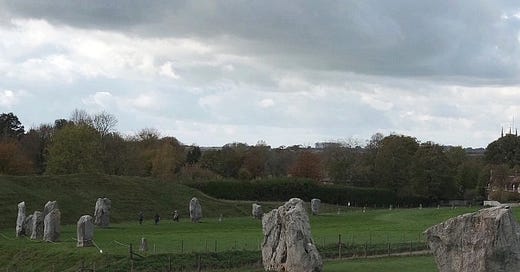Beltane: history, traditions, rituals. Part I.
What did our European ancestors celebrate on the 1st of May and why? Discussing the history, traditions and rituals of Beltane - the festival of fertility, sexuality and protection.
We are reaching the 1st of May — the peak of spring, its mid-point, the day right between the Spring Equinox and the Summer Solstice.
The day bears many names in European cultures: Beltane, May Day, Wulpurgisnacht, Valborg, Vappu, Arminden(i), Calendimaggio, Calan Mai – just to name a few.
If we put aside the words and the actions and instead look at the heart of it, we can see the ever-present theme of this day: if the Vernal Equinox was a herald of Spring’s coming, on the 1st of May we celebrate the implicit and obvious victory of warmth over coldness, of Life over Death, of Spring and the light part of the year over Winter and the dark part of the year.
In this article, I will be calling the festival Beltane, as it is known on the Celtic Wheel of the Year, but always bearing in mind — and heart — that it is less about the name and more about the underlying meaning and intention.
On the day of Beltane, we are celebrating Earth’s powers which are out there now: pulsing, blooming, buzzing, singing, dripping, swelling, growing, mating. We are reminded of the vital energy which runs through the world and lives everywhere – including in us, humans, too. We are witnessing Earth’s capacity for renewal, her creative force, her endless beauty and imagination.
Reflecting on the old customs, we can notice the main themes of Beltane: sexuality, fertility and protection.
Sexuality as the Life Force itself. The power that creates everything in this world. Which includes but is far from being limited by sex.
Fertility of the fields, fertility of the cattle, biological fertility of women and men as well as creative fertility — an ability to conceive that which hasn’t existed before.
And the protection of all of the above.
It was not a celebration lush in the food on the tables – not yet – but it was a celebration lush with Life Energy: fires, flowers, songs, dancing, laughter, love and passion.
There was not much yet, but there was a desire for what was to come.
A desire for a good, fruitful season. A desire for an abundance of colors, scents, tastes. A desire for community and togetherness. A desire for happiness and health. A desire for one another. A desire for Life.
Beltane rituals & traditions
In this article, I would like to discuss a few emblematic elements which I believe represent the underlying ideas and the spirit of Beltane as such. They are all related to the three festival’s themes I have highlighted earlier – sexuality, protection and fertility – and can be found across different European cultures to a varying degree.
Beltane Fires: Tein'-éigin, the Need Fire
Beltane is one of the Four Great Fire festivals of the Celtic calendar and it is customary to celebrate it by making a community fire on hilltops, gathering people around it for the rituals.
Surviving pagan customs of Beltane mention a special fire lit on the shabbat – tein'-éigin (tine-aye-gan) or a ‘Need Fire’ in English.
On Beltane Eve, all the hearth fires and candles in the community’s houses were put out and the next morning a selected few people would start the Need Fire on a hilltop using the old method of fire-making: creating friction of one piece of wood on another. Why put so much effort if there were better kindling ways devised? Because the beneficial properties of the Need Fire are many and such goodness must be earned. For instance, the smoke of the fire was believed to shield both livestock and humans from illnesses and to protect people from malicious witchcraft or bad luck. Therefore, cattle and sheep were led by the herdsmen around the Need Fire several times so that the animals were “washed” in the smoke and therefore cleansed. [1]
The beneficial properties of the Need Fire are many: the smoke of the fire was believed to shield both livestock and humans from illnesses and to protect people from malicious witchcraft or bad luck.
Other sources mention the making of two fires for Beltane: one to cleanse and protect, another one to strengthen creative – and procreative – powers. People and animals would walk three times between the fires to cleanse themselves and to fill their bodies with the fresh energy of the Beltane fire.
After the celebration was over at the sunset on the 1st of May, each family took embers from the community bonfire and carried them to their homes to start hearth fires anew.
It is worth noting that, not all Beltane fires were Need Fires and people did make them the usual way too, especially later on in history. On the other hand, the Need Fire was a powerful tool used by people not only on special calendar dates like Beltane and Samhain but also in times of hardships when the community was struck down with an illness or some other misfortune.
The Need Fire was a powerful tool used by people in times of hardships when the community was struck down with an illness or some other misfortune.
The special Need Fire is not unique to the Scottish Highlands: a similar tradition exists in, for example, Slavic culture where this fire is known as a ‘Sacred Alive Fire’ which was also made with the friction of wood and was believed by Slavs to ward off illness and to protect from hexes.
Beltane oat cake
Another Beltane tradition that was popular in the Scottish Highlands at least up until the mid-18th century was connected to an oat cake. [1]
A simple oat loaf was cut into many pieces and put into a bag, after which everyone had to take a piece of cake out with their eyes closed. One of the pieces was somehow marked (usually being darker) and whoever got that piece became a ‘cailleach bealtine’, meaning something like “the old woman of Beltane”. Cailleach is a hag-goddess in Celtic mythology, an old woman and the Queen of Winter – keep that in mind when reading what happened next after the person was identified.
Cailleach is a hag-goddess in Celtic mythology, an old woman and the Queen of Winter.
Cailleach bealtine was then picked off the ground by a few others who pretended to want to throw the person into the fire. As the rest of the community would step in, asking to let him/her go, the cailleach was spared but the name would stay with the “unlucky” one until the next Beltane. [1]
This seems to be a variation of the tradition of “burning winter”, making it leave and give way to spring. Traces of similar customs – like burning a puppet that represents Winter or a Queen of Winter – can be found across many European cultures.
Maypole
After the Beltane fire is lit and the customary actions are performed, the youth of both genders was sent to the woods for the rest of the night. Besides being given the time to fulfill their carnal desires, young people were also tasked with gathering flowers and finding a tree trunk for the May Pole. [2]
On the morning of the 1st of May, the chosen tree trunk was brought into the village, stripped off (most) of its branches and decorated with ribbons and flower garlands. After that, it was ready to be erected and become the center of the day’s community celebration, which famously included dancing in a circle around it.
There are ongoing debates regarding the symbolism of the maypole: some scholars see it as a symbol of the world axis (axis mundis), while others claim it to be a remnant of pagan tree worship practices. There is also a theory of the maypole being a phallic symbol, which would make sense in connection to Beltane’s themes of fertility and sexuality.
I personally relate to the idea that the trees brought to be maypoles were the symbols of longevity, nature’s power, cyclicity of life and connection to the divine.
Trees epitomize longevity because their lives span many human lifetimes. They personify cyclicity because they change with the seasons and visibly come back to life in spring. And in the case of evergreens, staying green all year was seen as a supernatural power. Lastly, trees are connecting the worlds of man and the divine because their crowns reach up to the heavens, their trunks live in our dimension and their roots penetrate the realm of the underworld. [2]
This is the end of Part I, hope you enjoyed it!
If you found this article interesting, share it with someone who might be curious to learn about the traditions of Beltane:
In Part II I will cover the following:
Is Walpurgis Nacht exactly the same as Beltane?
Why sexuality (including that of the “witches” of Walpurgis Nacht) was demonized?
What do Beltane and Samhain (a.k.a. Halloween) have in common?
Remembering the deceased ones around the time of Beltane.
What we, as modern-day humans, can do to connect to this ancient festivity and celebrate Beltane, wherever we are? With a pinch of spiritual and esoteric take on it.
So if you want to learn more, subscribe below and get Part II in your inbox:
See you soon!
Nika Trifo
Sources:
[1] James Frazer, “The Golden Bough”. See the sections: ‘The Relics of Tree-Worship in Modern Europe’ and ‘The Beltane Fires’.
[2] Arthur George, 2015, “The Mythology of May Day III: Maypoles and their Rituals”, Mythology Matters, accessed in April 2023, <https://mythologymatters.wordpress.com/2015/05/01/the-mythology-of-may-day-iii-maypoles-and-their-rituals/>.
This article is based on both reading various sources and opinions as well as learning directly from people who carry the tradition on in their lives. Whenever I can pinpoint the specific source where the information can be found, I do so. Many things are a compilation of my accumulated knowledge and personal interpretation.





